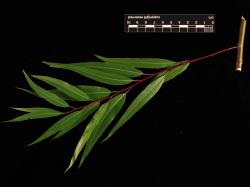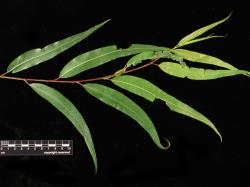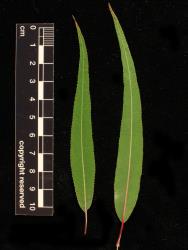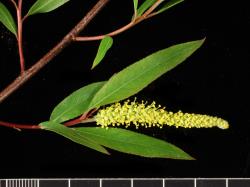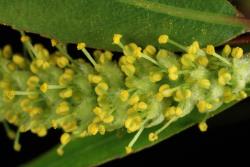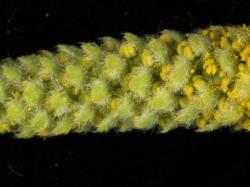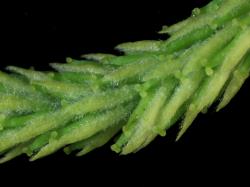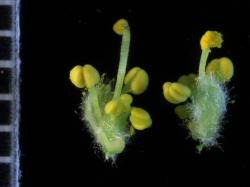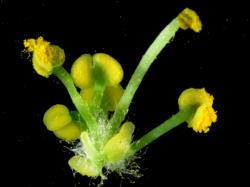Tall, erect trees. Current year's branchlets glabrous, dark red to dark reddish brown (UCL16–44), 2.3–2.6 mm diameter. Flower buds 6.5–7.0 mm long, 2.8–3.1 mm wide, narrowly ovoid, keels absent, moderately densely long-silky hairy. Stipules deciduous, ca. 1.5 mm long, asymmetrically narrowly ovate and auriculate. Petiole 3–15 mm long, densely tomentose in groove, glands absent or small and spherical as on the leaf margin, petiole base pinky red to red. Emerging leaves green, glabrous. Proximal leaves toothed. Leaf lamina 83–158 mm long, 9–29 mm wide, length to width ratio (5.0)6.0–13.4: 1, very narrowly ovate, falcate or straight; base cuneate; apex very narrowly acute; leaf galls absent; orange rust absent in late summer; margins densely serrulate, flat; upper lamina surface midvein and sometimes side veins raised, medium glossy, glabrous, stomata dense; lower lamina surface not glaucous, glabrous, midvein and sometimes side-veins raised, very little difference in appearance between upper and lower surfaces. Catkins emerging coetaneously with leaves. Flowering branch 60–92 mm long, with 4–6 leaves. Male catkin 52–57 mm long, 14 mm diameter; catkin rachis not visible between flowers. Female catkin 16–63 mm long, 2.5 mm diameter; catkin rachis not visible between flowers. Flower bract 1.8–3.2 mm long, 1.0 mm wide, pale yellow-green, channelled and curved inwards on long axis; apex acute, hairs dense to moderately dense all over or confined to margins. Male nectaries 4, innermost nectary 0.4–0.8 mm long, 0.3–0.5 mm wide, yellow-green. Stamens 6, filaments free, filament hairs present at base; anthers 0.5–0.7 mm long, yellow. Female nectary 1, 0.3 mm long, 0.6 mm wide, yellow; ovary ca. 3.5 mm long, glabrous; ovary and style equal in length to flower bract; stipe 1.0–1.6 mm long; style base 0.25–0.3 mm long; style arms very slightly lobed at their apices.
A tall tree with long terminal branchlets (60 cm or more long), and young branchlets are red (unusual in subg. Salix) and glabrous. Leaves are long (83–160 mm) and narrow (9–29 mm), and very narrowly ovate. Leaves are not glaucous, and both surfaces are nearly the same colour. Leaf texture is thin and the fine tips often break from wind damage. Leaf margins are densely and finely serrulate. Stomata are dense on both leaf surfaces but slightly denser below. The leaf lamina is glabrous, but the petiole has hairs and is dark red. The stipule is rapidly deciduous and is only 1.5 mm long, with obvious marginal glands. Flowering branchlets are long (30–40 mm below the catkin). Catkins themselves are long and narrow. Flower bracts are densely silky hairy on both surfaces and are slightly convex seen from outside. Male flowers have 4–6 stamens with filaments hairy at their bases, the anthers yellow and small (0.5–0.7 mm long). Ovaries are on a long stalk, 1.0–1.5 mm long.
Most similar to Salix gooddingii, the two being very similar in leaf size and shape, the lamina being almost the same on both sides, and completely glabrous. Catkins are also very similar but male flowers of S. nigra have 6 stamens while S. gooddingii has 4 stamens in New Zealand. Female plants will be S. nigra as only male plants of S. gooddingii are present in New Zealand. Salix acutifolia also has long, narrow leaves, which are glabrous, but glaucous on the underside. Salix eriocephala × S. petiolaris also has long, narrow leaves, which are glabrous, and are on red, glabrous branchlets, but the leaves are glaucous below.
Canterbury (Riccarton 1987).
A single naturalisation record from Riccarton where seedlings were establishing in disturbed bare soil with no adult trees nearby. In cultivation at Aokautere and likely to be present in cultivation elsewhere in New Zealand. In Australia Salix nigra is a declared plant and reproduces there from seed.
First collection: CHR 130288, W. R. Sykes, 10 October 1962, Christchurch Botanical Garden.
First publication: This publication.
Flowering: Early September–early November.
Diploid (2n = 38, CCDB based on two counts). Flow cytometry provisional results show a mixture of diploid (PN733) and tetraploid (PN734). PN732 is female but has a few male flowers in the catkins, and emerging leaves are densely hairy on the midvein, and must be a hybrid, the other parent unknown.



